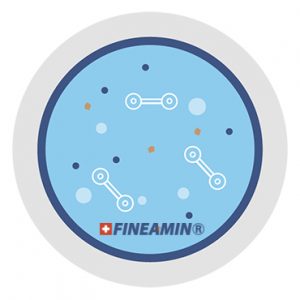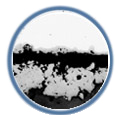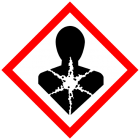FINEAMIN
polyamines-based, film-forming blends

CONVENTIONAL TREATMENT
hydrazine, phosphates, ammonia

- FINEAMIN® is a safe and easy to use alternative to common methods of treatment, a corrosion inhibitor with the ability to protect the entire water/steam/condensate cycle by forming a thin, homogeneous polyamines film at a molecular level, on all system parts.
- The polyamines film acts as a barrier between water carryover and metal – the absorbed amines improve the quality of the magnetite layer and keep any corrosion agents or deposits away from the underlying metal.
- The polyamines film prevents the magnetite layer growing more than necessary, improving the heat transfer for the metal walls.
- By contrast to phosphates, the FINEAMIN®, components are adsorbed on the crystalline compounds of calcium and magnesium and hence prevent further crystal growth and sludge formation. The crystalline precipitates gradually become amorphous and loosely adherent facilitating online cleaning.
- Conventional water treatment includes multiple products with different roles according to systems’ parameters: toxic oxygen scavengers (hydrazine) to act against residual oxygen, phosphates to control and adjust the pH, polymers to prevent “phosphates hideouts” etc.
- Traditionally used products like hydrazine or carbohydrazide act in the system as oxygen scavengers by removing the dissolved oxygen from water in order to stop it from attacking all metal parts that get into contact with water.
- The magnetite layer is thick, uneven and in case of high caustic concentrations, it is constantly dissolved, causing damage to base metal and leaks.
- The phosphates used for conventional water treatment, have the role of maintaining the pH, while precipitating the salts. The phosphates form hydroxyapatites of calcium and magnesium which are non-adherent and develop soft boiler sludges.
FINEAMIN
polyamines-based, film-forming blends

CONVENTIONAL TREATMENT
hydrazine, phosphates, ammonia

- Only ONE already prepared, multi-functional, water conditioning blend, delivered in 30kg, 60 kg and 210 kg drums or 1000 kg bulk containers. Our FINEAMIN polyamines formulations are OEM-compliant and can be dosed using the same equipment as for conventional treatment.
- FINEAMIN chemicals are ready to use, multiple purpose (all in one) products. Each mixture contains: film-forming amines, dispersing polymers, neutralizing amines. In extreme cases, can contain organic oxygen scavenger. One product protects the system and keeps all parameters under control.
- Chemical product quantity to operate with is reduced to up to 70% in some cases.
- During boiler conservation or system shutdowns, there is a special 48 hour shock dosing program available and the system remains protected for months.
- Multiple conventional water treatment products, with their own dosage, separate packaging, requiring from the final user to make their own proportional addition of each product to prepare a mixture on the spot, before dosing – harder control over the chemical regime.
- Conventional means of industrial water treatment involve more than one product to satisfy every need imposed by the system: an oxygen scavenger to remove the residual oxygen from the water, phosphates for cleaning, ammonia for stabilizing the system pH and so on.
- Large quantities of multiple products.
- During conservation or shutdowns, the system remains unprotected to water contamination.
FINEAMIN
polyamines-based, film-forming blends
![6643 [Converted]-03 6643 [Converted]-03](https://h2o-fineamin.ch/wp-content/uploads/2020/08/6643-Converted-03-400x150.png)
CONVENTIONAL TREATMENT
hydrazine, phosphates, ammonia
![6643 [Converted]-02 6643 [Converted]-02](https://h2o-fineamin.ch/wp-content/uploads/2020/08/6643-Converted-02-400x150.png)
- Decreased maintenance costs: The film formed by the FINEAMIN® polyamines on the metals surfaces inside steam systems, cooling towers and hot water pipes isolates any harmful agent that could produce leaks or damage to the equipment. Less repairs and replaced parts.
- No money spent on risky, extra chemical cleanings: The FINEAMIN® products contain dispersing agents that do their own online cleaning and the film formed on the metal surface stops scale and sludge accumulation, drastically decreasing or canceling the need for problematic chemical cleanings. Polyamines do not allow contamination deposition, keeping pipes clean for long periods of time.
- By acting on the magnetite layer and increasing its quality while decreasing its thickness, the heat transfer is improved, reducing excess energy consumption, meaning less costs for energy necessary to operate.
- Blowdown is also reduced as the cleaning of the system is continuous, there is no extra-sludge formation, resulting in lower water consumption.
- Only one chemical used for the whole water circuit conditioning. Lower quantity means less money spent on treatment products. Amines travel throughout the water and return with the steam. Continuous protection, less shutdowns, less product used.
- No special storage or transport conditions needed. Meaning less costs with handling and storage.
- High maintenance costs due frequent shutdowns for pipe damage repairs and replacement, sludge accumulation, chemical cleanings. Conventional treatment uses chemicals that in high concentrations damage the plant equipment through corrosion.
- Not wanted, but necessary chemical cleanings: They are required for the removal, in lower pressure boilers, of the calcium carbonate and other hard adherent scales and in higher-pressure boilers, of magnetite and copper deposits, in order to prevent metal overheating, gauging, contamination accumulations that could lead to corrosion.
- Conventional water treatment that is often hard to control can generate an uneven and thick magnetite layer that decreases the operational efficiency, needing more energy to operate and involving higher costs.
- Blowdown is constantly needed as the sludge resulted from phosphate precipitation has to be eliminated from the system, increasing water consumption.
- Large quantities of multiple products needed, involving higher costs for the overall water treatment chemicals aquisition, as well as for their handling and storage. Most of them are eliminated by frequent blowdown, requiring replacement.
- Special storage & transport conditions apply. Sometimes, this involves costs for building new storage facilities.
FINEAMIN
polyamines-based, film-forming blends

CONVENTIONAL TREATMENT
hydrazine, phosphates, ammonia

- In the case of FINEAMIN, the most important parameters that need to be measured are: Fe content, the pH, conductivity and polyamines excess. There is no need for residual oxygen measurements as the film formed by polyamines separates water from the metal surface, isolating the oxygen. No matter the quantity of dissolved oxygen from the water, the pipe is continuously protected.
- Stable analyses. Scientific interpretation. Stable pH, no solids are generated. Alkalinity control and reduction of corrosive substances.
- Determination of FINEAMIN excess can be done using any good quality spectrophotometer. Reagents for analysis and an easy to follow calibration curve are provided.
- In the case of conventional treatment, not only the pH, conductivity, silica, and sodium need measurements, but also the dissolved oxygen, hydrazine concentration, phosphates and all other additives. The more parameters are required to be followed, the harder the process to control the water chemistry becomes.
- Errors in analysis. Low pH control and contamination concentrations. Low alkalinity control.
FINEAMIN
polyamines-based, film-forming blends

CONVENTIONAL TREATMENT
hydrazine, phosphates, ammonia

- Thermal decomposition products: FINEAMIN® chemicals can be used in steam water circuits with pressures up to 220 bar and temperatures up to 540°C due to their very low degradation ratio. FINEAMIN chemicals generate ammonia and acetate in an almost insignificant quantity – as low as 1 ppb for 1 ppm dosed product.
- FINEAMIN® products are blends that decompose in various parts of the system, according to temperatures and system needs. They do not react in any harmful manner with anything inside the system. Part of them are are adsorbed on the crystalline compounds of calcium, facilitating their online cleaning.
- Using FINEAMIN® organic additives for steam water circuits will not harm the equipment as the resulting degradation products are in no case corrosive due to their very low quantities.
- Thermal decomposition products: Hydrazine begins to decompose at approximately 200°C and a significant amount of ammonia is formed, attacking primarily copper and copper alloys from the condensate line and feedwater system. One of its substitutes, carbohydrazide, releases hydrazine and carbon dioxide in high temperature conditions.
- Precipitation: Under high heat transfer or high pressure conditions, phosphate compounds interact with iron oxide and ionic phosphate disappears. This reaction generates a low solubility product that precipitates, forming the so called hideouts, often hard to remove and leading to corrosion.
- When using traditional methods, the plant life is shortened by uncontrollable water chemistry and severe corrosion generated by decomposition products of hydrazine, but also due to the accumulation of sludge if phosphate treatment is not properly conditioned with additional additives such as polymers.
FINEAMIN
polyamines-based, film-forming blends

CONVENTIONAL TREATMENT
hydrazine, phosphates, ammonia

- FINEAMIN® industrial water treatment products are non-toxic! They can be handled by instructed personnel with the minimum, conventional protection equipment. They do not have any dangerous, long term effects on humans if handled with care and according to the Safety Data Sheet.
- FINEAMIN® does not involve any special measures for storage of dangerous products. FINEAMIN® anti-corrosion additives can be stored for up to 5 years, without any problems, in a ventilated space, respecting the required temperatures: 5°C to 45°C, along with other chemicals, in the same storage facility. It is not flammable and does not present an explosion risk.
- FINEAMIN® chemicals are organic additives for water treatment that do not have long or short term impact on the environment. Up to 80% biodegradable!
- Oxygen scavengers such as hydrazine are extremely toxic chemicals, known to posses severe health threats. Short-term exposure of humans to high levels of hydrazine may determine eye irritation, headaches, nausea, seizures, damage to internal organs or nervous system. Long-term exposure can provoke cancer.
- Hydrazine hydrate is an easy flammable substance that can’t be stored together with metal oxides or porous materials, close to any sources of heat or ignition. Dedicated storage facilities are required: well ventilated, inert atmosphere, with explosion-proof electrical equipment and well equipped with retention tanks in case of accidental leaks.
- Hydrazine hydrate does not show signs of persistence or bio-accumulation potential, but it does involve inherent, high toxicity to aquatic organisms.

